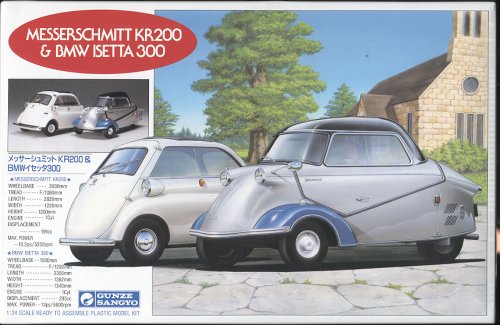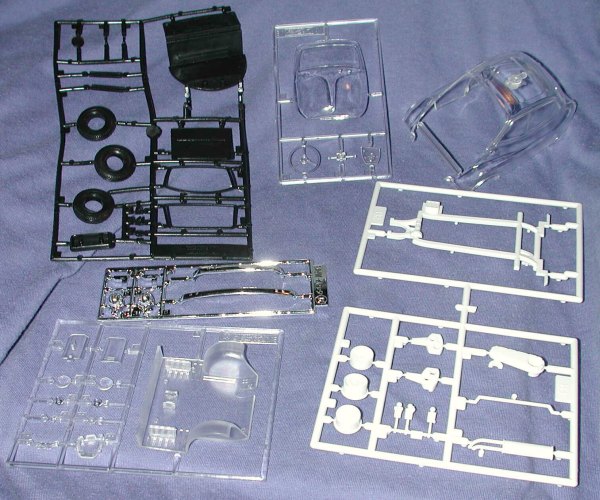
|
KIT: |
Gunze Sangyo 1/24 Messerschmitt KR 200 and BMW Isetta 300 |
|
KIT # |
G-196 (14) |
|
PRICE: |
$27.95 MSRP |
|
DECALS: |
N/A |
|
REVIEWER: |
Scott Van Aken |
|
NOTES: |
Includes vinyl and etched brass parts |

|
HISTORY |
The Messerschmitt KR 200:
In Germany 1948, Fritz Fend (a former aircraft designer) introduced the Fend Flitzer. This was a single seater invalid vehicle which formed the basis of a two seater version; the Fend Kabinenroller FK 175 (The Messerschmitt 175) Fend had approached Professor Willi Messerschmitt along with his idea for a two seater version. Messerschmitt offered the facilities of his factory in Regensburg and it was there that Messerschmitts were made.
The first "Flitzer" Messerschmitt was introduced in 1953 after appearing at the Geneva Salon in March of the same year. The Messerschmitt stands at just over 4 feet from the ground and has a monocoque construction. The top of the vehicle was hinged to allow access and the passenger seat was directly behind the driver. The reason for this it was said was to improve the aerodynamics of the car rather than having the wider twin seats at the front combination. The two front wheels were controlled by handlebars and it had a single driven wheel. When Messerschmitt was asked to summarize his design in one word he replied, "weglassen" - a paring down of all but the essential parts. This can be seen in the vehicle with the small engine size that is compensated for by the body shape which helps minimize aerodynamic drag. At the time other 3-wheelers were far from aerodynamic. There was a legend that Messerschmitts were built from modified surplus cockpits for ME 109's but looking at the appearance this is false.
In 1955 the Messerschmitt KR200 was introduced. Whilst externally it looked the same it was now powered by a 191cc Sachs engine that gave the car a top speed of 65 mph and a fuel consumption of 87 mpg. In 1958 the Messerschmitt TG 500 (The Tiger) was launched. This was a 4-wheeler with a 500cc engine and a top speed of 89mph.
Large numbers of KR200's were sold worldwide until production stopped in 1964.
The BMW Isetta 300:
These cars were first built by a Milan-based manufacturer, Rennzo Rivolta. He was a refrigerator manufacturer until 1953, when he decided to start building cars. His first model, the Isetta or little Iso, has a few refrigerator features! This was the start of the Bubble Cars as we now know them today.
In 1955 Rivolta sold the rights to BMW, who were, at the time, in sorry financial state and seeking a small, affordable car to boost sales. BMW replaced the original two stroke engine with a four stroke motorcycle engine, modified for operation in automobiles. It, like the Messerschmitt, is a three wheeler, though later designs had four wheels. In most countries, three-wheel cars are licensed as motorcycles, thereby getting past the restrictive tax and licensing fees that are often placed on regular cars. These cars were not designed for high speeds and open highways, but more for getting around town and traveling relatively short distances.
|
THE KITS |

Though two complete kits are provided, I'm only going to show the parts for the BMW and focus my comments on that one first. As you can see, there is a LOT of clear plastic with this kit. The entire upper and lower body is clear as is the steering wheel,instrument panel parts, lights and a few other small bits. With the body loose in the box and the other clear bits bagged with the other sprues, the parts have been scratched and will need some polishing. It makes sense to mold the upper body parts and light lenses in clear, but I'm not sure why that was done with some of the other bits.
The entire interior is done in black vinyl along with the wheels, roof tarp, window moldings and a couple of other small parts. Apparently one is not expected to paint these bits and just use them as they are. It will be interesting to see how well these parts will stick once glued. The chrome sprue is well done and includes bumpers, headlight bezels, door handles and forward bumper braces. Normal plastic is limited to the chassis, wheels, drive belt housing, foot pedals, front suspension pieces and exhaust. There are small rivets to hold the wheels in place and etched metal is used for license plates, windscreen wiper and logo.
Much the same can be said of the Messerschmitt, though there is less clear plastic and more chrome. Vinyl is limited to weather-stripping and tires. There is a front axle and a rivet for the rear wheel. The clear plastic is limited to the top and lights, though these parts are also scratched from being in a bag with other sprues. Etched metal is used for logos, plates, and wipers
|
CONCLUSIONS |
I've been wanting this kit for quite some time, but the last time I saw it (several years ago), it was nearly $35. The price this time is still a bit high, but more in the range of what I was willing to spend. According to the box side, this is a 1994 kit, so I expect construction to present no real problems in terms of fit and engineering. One thing for sure, it will be something a bit different from the norm!
If you would like your product reviewed fairly and quickly by a
site that has nearly 250,000 visitors a month, please contact
me or see other details in the Note to
Contributors.